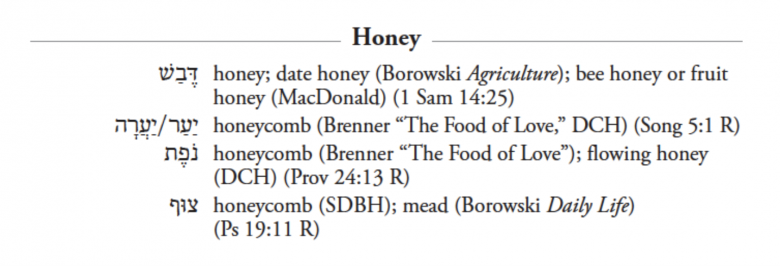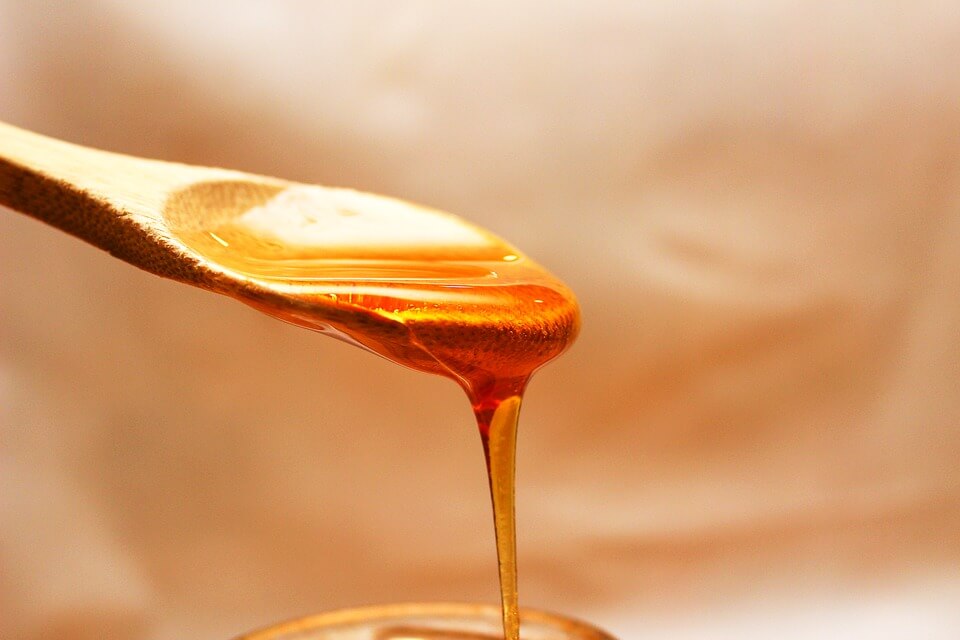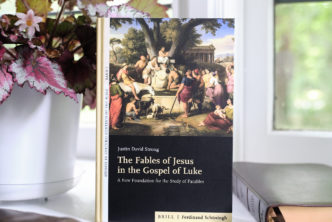
In 2017, David Pleins and I released a new resource designed for students of Biblical Hebrew: Biblical Hebrew Vocabulary by Conceptual Categories: A Student’s Guide to Nouns in the Old Testament (Zondervan, 2017), a user-friendly book from Zondervan that arranges Biblical Hebrew words and phrases into categories from water to warfare, from jars to genitalia. Since then, we’ve gotten positive reviews in several journals, including the Review of Biblical and Early Christian Studies, Journal for the Study of the Old Testament, Expository Times, Bulletin for Biblical Research, Review of Biblical Literature, and Hebrew Higher Education. This blog series at theLAB aims to show how this book can be useful for students of all levels. (Links to previous posts will be at the bottom of this page.)
Interested in biblical word studies, but stymied on how to take them to the next level?
Decades ago, biblical linguist James Barr wrote of the dangers of a “word studies” approach to studying the Bible. We’ve all seen it happen. After two semesters of Biblical Greek or Hebrew (or even one), the concordance comes out, and the student believes they have found some “deeper, hidden meanings” of the Bible by solely flipping through a concordance. Just gander at the amount of ink spilled on the supposed distinction between agapeō and phileō in Jesus’ repeated question to Peter, “Do you love me?” (John 21:15–17). Don Carson has a whole chapter on common word study mistakes in his Exegetical Fallacies. As Douglas Mangum notes in his introduction to Bible Word Studies: A How-To Guide, “The tendency to draw inappropriate conclusions from limited information makes many Bible scholars wary of word studies.”
However, as Mangum goes on to note, word studies can be useful if they are conducted with a sophisticated understanding of how language works. One of the problems with word studies is that they often study words in isolation. But words only make sense in the context of related words.
I’d like to illustrate the power of Biblical Hebrew Vocabulary by Conceptual Categories to deepen Biblical Hebrew word studies. Lately, I have been studying the Song of Songs, ancient Israelite love poetry often read as a dialogue between humanity and God. The Song is known for its dense symbolism; its metaphors are sometimes hard to grasp. Take this line:
Your lips distill nectar [nophet], my bride;
Honey [debash] and milk are under your tongue;
the scent of your garments is like the scent of Lebanon. (4:11)
This verse appears in a section where the male lover praises the female lover’s body, part by part. These two words, nophet and debash, both seem to refer to some kind of honey. But how exactly do these words, used in parallel,1 relate to one another? And how can we use them to understand all the associations of honey in the ancient Israelite imagination? To answer these questions, we turn to Biblical Hebrew Vocabulary by Conceptual Categories, which has a list of four total terms for honey:

Each of these four words2 falls in the semantic domain of “honey.” Brenner, Borowski, and MacDonald3 each give slightly different nuances to each word; we include all the possible nuances they bring up. Three of these entries are marked “R” for “rare,” indicating that they appear fewer than 10 times. According to the Dictionary of Classical Hebrew (DCH), two of these rare terms, nophet and tsuf, appear only in poetic texts: Proverbs, Psalms, and Song of Songs. By contrast, DCH enumerates 54 occurrences of debash in the Bible.
The takeaway: before we turn to any particular passages, we can infer from this list in BHVCC that one of these terms is the more common, prosaic term for “honey,” and the other three are less common. As in English poetry, the poets of ancient Israel like to play with obscure words!
Debash
Starting with a study of the word debash, what can we learn from the Bible about honey?
- Honey is sweet: Ezekiel tells us that when he ate the scroll of God’s Word in his prophetic commission, “in my mouth it was as sweet as honey [debash]” (3:3).
- Honey is smooth: As the Psalmist says of the Torah, “How sweet are your words to my taste, sweeter than honey [debash] to my mouth!” (119:103).
- Honey is a fine food, maybe even a luxury: When Jacob tells his sons to take “some of the choice fruits of the land” to the overseer in Pharaoh’s house (Joseph), he lists debash among those choice fruits (Gen 43:11). And of course who can forget that Canaan is the land of milk and debash, and that the manna in the desert in Exodus is said to taste like “wafers made with debash” (Exod 16:31)?
- Honey might be nauseating in excess, just as sweet foods are today. Proverbs states, “If you have found honey [debash], eat only enough for you, or else, having too much, you will vomit it” (Prov 25:16).
These immediate associations with “honey” shed light on the metaphor in Song 4:11. The author describes his love’s mouth as sweet and smooth and brings up associations with wealth and agricultural fertility.
However, the human mind does not traffic in isolated terms. We understand words and concepts in a thick web of other words and concepts. This is where BHCVV comes in handy because it lists other words in the semantic domain of debash.
Nophet
The other word the author of Song uses, nophet, likely means something similar to debash because of its parallel usage. According to DCH, nophet is only used six times in the Bible—only in Proverbs, Psalms, and Song of Songs—so we should not expect too much precision in defining it. Still, we can guess. It may be a particular type of or state of honey. Or it may carry a different connotation while referring to the same object, like “domicile” versus “home.” For example: in her commentary on the Song, Cheryl Exum argues that “nōpet refers specifically to honey from the honeycomb, flowing honey, whereas debaš is a common word for honey.”4
We find nophet used in parallel with debash not only in Song 4:11 but also in Proverbs:
My child, eat honey [debash], for it is good,
and the drippings of the honeycomb [nophet] are sweet to your taste. (Prov 24:13)
Michael Fox, commenting on this passage, remarks that
Other things likened to honey are seductive speech (Prov 5:3), pleasant words (Prov 16:24), wisdom (Sir 24:20), and God’s words and commands (Pss 119:11, 119:103). Especially interesting is the use of honey to represent both sensual temptation and intellectual pleasure.5
Hence, turning to nophet brings up the Wisdom associations with honey, giving us more depth on the Song of Songs’s use of the honey metaphor.
Tsuf
But wait—there’s more! We turn to the Psalmist:
The ordinances of the Lord are true
and righteous altogether.
More to be desired are they than gold,
even much fine gold;
sweeter also than honey [debash],
and drippings [nophet] of the honeycomb [tsufim]. (Ps 19:9b–10)
Another word appears: tsuf, used twice in the Hebrew Bible. Its other use may allude to another association of honey in ancient Israel:
Pleasant words are like a honeycomb [tsuf-debash],
sweetness to the soul and health [marpē] to the body. (Prov 16:24)
Many cultures in the ancient world used honey medicinally: it is known to have antiseptic properties, and some suggest it strengthens the immune system.6 Is it possible that this passage hints at a similar use of honey in ancient Israel? If so, what might that tell us about the Song’s construction of gender, given the possible involvement of women in ancient Israelite folk medicine?7
Ya’ar/Ya’arah
This last term only appears twice. First, it appears in a story in 1 Samuel 14:24–31 in which Jonathan eats honey before battle in contradiction to his father’s oath before God that his soldiers would not eat:
But Jonathan had not heard his father charge the troops with the oath; so he extended the staff that was in his hand, and dipped the tip of it in the honeycomb [beya’rah hadebash], and put his hand to his mouth; and his eyes brightened.
It’s unclear how this term differs from debash, tsuf, and nophet. Perhaps ya’arah merely refers to “comb,” which would explain why the narrator has to specify “a comb of honey.” Perhaps it refers to wild honey, as opposed to the date-based honey most likely eaten in ancient Israel.8 Maybe it is a long-forgotten idiom. Or maybe it reflects a different register, dialect, or chronology—which we explore in our next post.
Finally, this term for “honey” leads us back to the Song of Songs, back to the male lover rhapsodizing about his beloved:
I come to my garden, my sister, my bride;
I gather my myrrh with my spice,
I eat my honeycomb [ya’ar] with my honey [debash],
I drink my wine with my milk. (Song 5:1)
With the help of Biblical Hebrew Vocabulary by Conceptual Categories, we have not only taken a brief tour through the semantic field of “honey” but we have also found many possible nuances of the way the metaphor of honey is used in the Song.
Read with all the nuances of its symbolism, the honey-sweet lips of the female beloved in the Song are not just good for kissing but also for wisdom and healing.
1 On the relationship of terms in poetic parallelism, see David L. Peterson and Kent Harold Richards, Interpreting Hebrew Poetry, Guides to Biblical Scholarship (Minneapolis: Fortress, 1992), chap. 2; Adele Berlin, The Dynamics of Biblical Parallelism, rev. ed. (Grand Rapids: Eerdmans, 2007), chap. 4.
2 DCH and HALOT both classify ya’ar and ya’arah as two separate words; however, we include them here as spelling variants of the same word.
3 Oded Borowski, Daily Life in Biblical Times, Archaeology and Biblical Studies 5 (Atlanta: SBL Press, 2003); Oded Borowski, Agriculture in Iron Age Israel (Winona Lake, IN: Eisenbrauns, 1987); Athalya Brenner, “The Food of Love: Gendered Food and Food Imagery in the Song of Songs,” Semeia 86 (1999): 101–12; Nathan MacDonald, What Did the Ancient Israelites Eat? Diet in Biblical Times (Grand Rapids: Eerdmans, 2008).
4 J. Cheryl Exum, Song of Songs, Old Testament Library (Richmond: Westminster John Knox, 2005).
5 Michael V. Fox, Proverbs 10–31, Anchor Yale Bible (New York: Yale University Press, 2009), 748.
6 John F. Nunn, Ancient Egyptian Medicine (Norman: University of Oklahoma Press, 2002), 148; Gillian Patricia Williams, “A Talmudic Perspective on Old Testament Diseases, Physicians and Remedies” (MA thesis, University of South Africa, 2009), 207–8.
7 Carol Meyers, Rediscovering Eve: Ancient Israelite Women in Context (Oxford: Oxford University Press, 2012), 151–52; Hector Avalos, Illness and Health Care in the Ancient Near East: The Role of the Temple in Greece, Mesopotamia, and Israel, Harvard Semitic Museum Monographs 54 (Atlanta: Scholars Press, 1995), 240.
8 Borowski, Daily Life in Biblical Times, 29, 70; MacDonald, What Did the Ancient Israelites Eat? 39–40.
Pleins and Homrighausen’s Biblical Hebrew Vocabulary by Conceptual Categories: A Student’s Guide to Nouns in the Old Testament is currently on pre-order for Logos (almost funded!), and will be fully integrated and tagged for the best research and study experience possible. Get in on the special pre-order pricing of $11.99 now.





